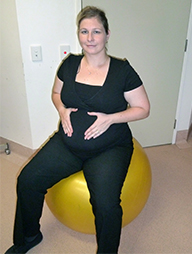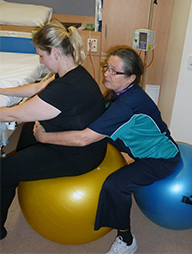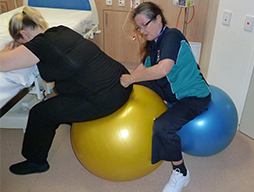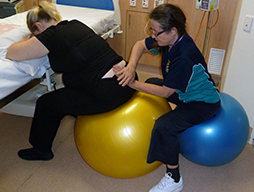Relaxation and pain management during pregnancy and labour
Massage and breathing techniques during pregnancy can help reduce stress during pregnancy and can be an alternative to pain relief medications (drugs) during labour.
Some people also find massage helps with sleepless nights after childbirth.
Massage can be done in any position and over clothes if you prefer. It should also be given evenly to both sides of the body.
Use cold pressed vegetable oil or aromatherapy oils. Be sure to warm the oil first with your hands. If you don’t like oil you can use talc powder.
The following tips can help your support person develop a massage technique that works best for you. There are no set rules.
Stroking is a massage method where the hands slide lightly along the surface of the skin.
Back
Stroke the mother’s neck down from the ears and let the stroke flow down the back. Continue down the legs to the feet. Start the next stroke slightly away from the midline of the back so eventually you cover the entire back.
Arms
Stroke from the upper shoulders down to the hands, encouraging low shoulders and long soft fingers.
Effleurage
Stroke from the hands or feet up towards the trunk. This assists with the flow of lymph towards the lymph nodes (base of neck, groin, arm pits and back of the knees) and can provide some temporary relief from swelling.
Abdomen
Sit the mother so she leans back into her support person or against a wall or beanbag. Stroke the top of her abdomen with both hands in the middle, and stroke out to the side. Gradually work your way down the abdomen. During labour, let the mother feel as if you are stroking her pain away.


 Kneading is a deeper, localised form of massage.
Kneading is a deeper, localised form of massage.
The hands are pressed down into the skin and moved in a slow circular motion, before moving on to another area of the body.
Double handed kneading provides a deeper pressure often useful for relieving lower back pain.
 Position the mother on her hands and knees or sitting on a fitball, The support person should place a relaxed hand above her tailbone and use their body weight to ‘rock’ the pressure on and off, keep their hand in contact with her body.
Position the mother on her hands and knees or sitting on a fitball, The support person should place a relaxed hand above her tailbone and use their body weight to ‘rock’ the pressure on and off, keep their hand in contact with her body.
When a contraction starts, most women find it more useful for the support person to ’rock’ the pressure on and maintain it until the contraction has come to an end. The alternating pressure can then continue until the next contraction.
This is a gentle technique – don’t press too heavily.
Frictions is a deep, localised pressure using your thumbs in a circular motion. This can be used on muscle knots in your shoulders or lower back.
During labour, don’t press too heavily.
Relaxed breathing may help manage stress during your pregnancy, labour and after delivery. Here are some breathing options you may wish to try in conjunction with other pain management strategies when in labour. Always listen to your midwife on when to use them.
Easy breathing with focus on outward breaths
This breathing technique involves a long easy breath out through a slightly open mouth.
Let your lips come together and pause while your body breathes in for you.
When you are ready to breathe out, repeat the long easy breath out.
Use this technique when you start having contractions and continue as the contractions strengthen and lengthen. You can add an ‘ooo’ or ‘ahh’ sound as the contractions become more intense.
SOS breathing
As your contractions become more intense, emphasise soft and slow sighs from slightly open lips.
Pant-pant blow
Use pant-pant blow to inhibit breath, holding and pushing. Use a separate breath for each pant and blow. Keep your breath soft and relaxed.
It is important to keep breathing and listen to your body.
This involve maintaining pressure over acupuncture points in the body.
It should only be applied during labour and is not recommended in pregnancy.
Speak to your physiotherapist or midwife for more information.
More information
Find out more about physiotherapy during pregnancy, pregnancy care, or return to the Maternity page.

